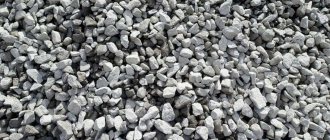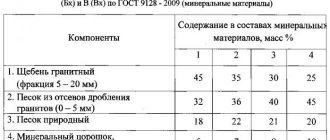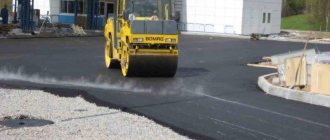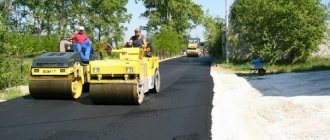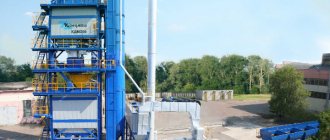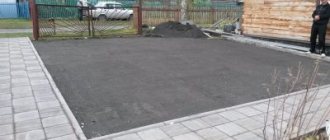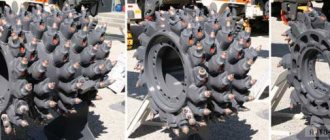Travel cosmetics
Recycling asphalt allows you to save significant money and time on road work. And here we cannot do without recyclers.
Recyclable materials
Asphalt is today the cheapest, but at the same time effective material for creating protective coatings on road surfaces. In the process of performing traditional technological operations for repairing road surfaces, large volumes of worn out asphalt removed in one way or another remain. This asphalt is classified as harmful to the environment. Reusing ABS to repair damaged areas of the road surface solves the corresponding environmental problems and brings tangible financial benefits (recycled asphalt is 10 times cheaper than the finished material of factory origin). Recyclers are designed for repairing small areas, and most often the raw material for a new coating is the removed layer of asphalt concrete pavement in the area being repaired. In addition, such recycled asphalt is quite suitable for strengthening embankments, ditches, ditches and other auxiliary elements of highways. These cars are most often in demand in the autumn-winter period. In addition to scrap asphalt concrete, recyclers are also capable of processing asphalt granulate - components of old road surfaces crushed in special mills, the parameters of which must comply with GOST R 55052. ABS, which is prepared with the participation of viscous bitumen fractions, has a melting point of 120...1400C. In this state, they are high-density materials, the viscosity of which, according to the requirements of GOST 22245, is 130...2000E. Grinding such scrap creates conditions for melting the fragments into a fairly homogeneous mass, which can subsequently be added to the main melt.
How does a recycler work?
A typical recycler is a mobile unit consisting of the following main parts: a) A sealed, closed hopper into which the material to be recycled is loaded. In some designs, the bunker is double-walled and is a thermos container. This significantly increases recycling efficiency. The internal body of the bunker is made of high-strength plate steel. Between the outer and inner casings there is a thermal insulation layer made of stone or mineral wool. b) A powerful heat gun, with the help of which scrap road surfaces melt, turning into a highly viscous medium. c) In some design types of recyclers, gas-flame burners are used instead of a heat gun; in this case, the melting of asphalt scrap is carried out with an open flame. Such installations are less environmentally friendly, although more simple. They are equipped with a hydromechanical drive, which periodically mixes the heated components d) Diesel-electric generator, which ensures the operation of the heat gun. e) A funnel-shaped nozzle that collects the resulting melt, from where it is discharged into special containers, or directly discharged onto a prepared base. f) Frame body with wheels for transporting the recycler. Recyclers are equipped with a pneumatic braking system, which is driven by the pneumatic braking system of the traction chassis (tractor), as well as a manual parking brake. The ABS recycler is aggregated with motor-tractor equipment of the 1.4 ton traction class. g) To drive the heat gun of trailed recyclers, a drive from the hydraulic system of the main equipment - tractor, heavy-duty vehicle, etc. is used. The work of a hot recycler is to melt asphalt waste and produce a homogeneous asphalt mixture by mixing. Recycling technology does not require, as is customary in stationary production, a dosed supply of a set of necessary components, pre-dried and heated to a certain temperature, as well as a number of other technological operations. During the production of the mixture, its composition can be adjusted. The quality of the melt increases if 2-3% is added to the original semi-finished product; bitumen After loading the mixture, the heat gun is turned on, and the temperature inside the bunker is monitored using instruments. The most attractive feature of the equipment is the possibility of year-round use.
What's on the recycler market?
The main technical characteristics of domestically produced recyclers are within the following limits: Capacity: 1200-3000 kg/h. Fuel consumption (for units equipped with burners): - 6-12 l/h. Heat gun power: no less than 39 kW Single load volume: kg – 350-500; Warming up time to a temperature not lower than 1500C: no more than 3 hours.
Asphalt recycler EMBIKA ERA 6,000 The recycler for recycling old asphalt is used for pothole repair of roads, or for sealing asphalt cuttings when repairing utility networks. Can serve as a melting tank for bitumen, transportation and delivery of cast asphalt, bitumen-mineral mixtures. In the budget version, the drive of the units is from the hydraulic line of the carrier (for example: MTZ tractor) or is equipped with an autonomous engine.
The RA-750TM trailer mounted asphalt recycler features combined heating, produces 3.5 to 5 tons of asphalt per hour and can be truck or trailer mounted
Asphalt recycler RA - 450: The main function of the equipment is the processing of milled asphalt and asphalt waste (crumbs) into full-fledged asphalt. The installation can produce from 1.5 to 2 tons of asphalt per hour
Recycler for asphalt recycling - RCA-1200 productivity - 2.5-4t/hour. The ability to work in continuous mode and intermittently is provided, lombardini diesel engine, power 12 hp. With.
The SMMT trailer mounted recycler is trailer mounted, equipped with a diesel burner, Honda engine.
The EM-3200 recycler processes old asphalt fractions, prepares cast mixtures from inert materials, and transports hot bitumen (a substance used in road construction). Productivity - 1.2 t/hour, fuel tank capacity - 36 l,
Portable mini asphalt recycler – Asphalt Recycler Pothole Patcher
The unit is designed for minor patching and correction of potholes on the asphalt surface of roads and sidewalks. In 10 minutes, the installation can produce up to 250 kg of asphalt concrete mixture from old lump asphalt or crumbs. Honda engine 11 hp
sdexpert.ru
Engineering of Technical Systems – Asphalt concrete recycler EM-3200
Recommendations for use of EM-3200
The heating chamber of the recycler must be warmed up for 10...15 minutes before starting work.
The procedure for igniting the fuel burner: with the tractor engine running, increase the pressure in the fuel tank according to the pressure gauge (0.4...0.6 MPa), open all exhaust can outlet hatches, open the fuel supply control valve until a stream of fuel appears in the air intake holes of the burner, open the control valve air supply valve. Next, ignite the fuel mixture with a torch through the air intake holes of the burner, using a compressed air supply valve, adjust the flame until a stable burning of a white-blue torch with a length of no more than 400 mm appears. The presence of soot and smoke during combustion is not allowed. Close the hatches, leaving one open on either side, located on the burner side to ensure optimal circulation of hot air.
The recycler container is loaded depending on the selected option for preparing the cast mixture.
With a break of 25...30 minutes, the mixing device is turned on for 1...2 minutes in forward or reverse directions. The average productivity of the recycler is 1.2 tons/hour.
Bring the temperature of the finished mixture to 190...200°C, monitoring the readings on a thermometer. It must be borne in mind that the thermometer correctly displays the temperature only when immersed in the mixture, which is unattainable when the container is not fully loaded. If the mixture is prepared in quantities other than the nominal quantity, the process of readiness should be monitored visually by the presence of boiling, while observing safety requirements.
If it is necessary to transport the prepared mixture, it is necessary to monitor the pressure in the fuel tank of the recycler, since at a pressure less than 0.3 MPa the burner flame fails and, accordingly, the mixture solidifies.
Due to the fact that different types of compressors (from 115 to 166 l/min) are used to equip tractor engines, the following rules must be adhered to:
during transport crossings, maintain engine speed within 1500... 1700 rpm, monitoring the readings on the tractor tachometer. To do this, it is necessary to ensure movement in lower gears of the gearbox, since at these engine modes the required volumetric flow of the compressor is ensured. During operation, experimentally, it is necessary to clarify the optimal engine speed.
To unload the mixture, turn on the mixing shaft. The design of the blades is made in such a way that when the mixing device rotates, the cast mixture is pushed in portions to the unloading device. The finished mixture is unloaded by opening the slide valve on the back wall of the heating chamber, directly onto the defective section of the road or into a special container (for example, a trolley).
system-teh.ru
TRADE INDUSTRIAL COMPANY AB – ASPHALT CONCRETE RECYCLER RA-500
ASPHALT CONCRETE RECYCLER RA-500
The device is designed for regeneration, delivery and storage of asphalt concrete mixture.
Recycle - (eng.) - recycle
Designed to reduce the cost of pothole repair of roads, covered with asphalt concrete with devices for infrared heating of asphalt.
The recycler is designed for the regeneration of cold previously harvested or lumpy previously used material, as well as milling material.
The recycler allows for a continuous repair process throughout the year.
Within a few minutes, hard asphalt, cold mix asphalt, and lump asphalt are transformed into a pliable hot mix suitable for laying. The material storage unit has a welded structure, is durable and easy to maintain.
The installation ensures heating of asphalt to a predetermined temperature when performing pavement repair work.
Capacity 2-2.5 tons per shift (1 cylinder 40 liters per shift).
Specifications:
Overall dimensions: 1200*1280*980
Fuel: Propane
Consumption: 3-4 kg. in hours (depending on the ambient temperature)
Volume: 0.5 tons
Control: mechanical (torch ignition)
Weight without cylinders: 220 kg.
www.podorozhnik.net
features of asphalt concrete EM 3200, PM 107
The concept of concrete recycling means the repeated processing of this material. And this is not just a pressing issue, but a very serious problem.
After all, very often there are situations when the owner of the facility or the foreman simply do not know what to do with stone piles of old mortar. And indeed, such material, as a rule, does not have clear forms, which means using it “as is” is either problematic or completely unrealistic.
Concrete mix recycler
There are still several options for solving the problem - they are discussed in the table below.
| How to use old concrete | Features of the solution |
| 1. Leave everything directly on site. | Here it is worth understanding in more detail. Leaving means either burying or creating garbage heaps on any part of the territory. The method has a right to life, but there is a “pitfall” - various inspections and environmental services can make a fuss. And this is fraught with fines, strict regulations, and even the fact that the object will not be delivered. |
| 2. Detail manually. | In this case, we mean that the concrete is split with one’s own hands using sledgehammers or powerful hammer drills into the smallest pieces possible. Such waste can be reused in the mixture (as a filler). However, this method can only be implemented if it is possible to involve a large number of people in the matter. But this is expensive, and besides, such work will not be quick in terms of time. |
| 3. Sell. | In principle, this is a pretty good option, but there are certain difficulties here. · Firstly, a buyer still needs to be found, and this is time, which is not always available. · Secondly, it is unlikely that you will be able to find a buyer for uncrushed concrete. |
As you can see, the conclusion suggests itself that the best way to solve the problem of recycling such concrete would be some method in which the processing would be as automated as possible. In addition, it is also important that recycling occurs really quickly.
Automatic Solution Recycling System
Therefore, manual labor is definitely not suitable here - its price is high, plus it is still ineffective if there is a large amount of work to be done.
Please also pay attention to the fact that you can’t do this with just picks and crowbars. In any case, workers will have to purchase power tools: chippers, hammer drills, etc. Which, again, is not cheap.
The best solution here is the use of crushing and screening complexes that have powerful magnetic separators. Naturally, this type of equipment itself is very expensive, and renting it is expensive. But with huge quantities of old solution, this technology is advisable.
This applies to solid concrete left over from the dismantling of buildings and structures.
Concrete breaker
But in addition to such waste, there is another problem associated with the recycling of concrete - the need to organize recycling of concrete waste that is generated by the plants themselves.
After all, even the instructions for preparing the solution itself, by default, assume that in production bunkers and in automixers there will be a lot of mixture left on the walls (from 4 to 10% of the total volume of concrete). And usually all this is poured into a pit on the territory of the plant, and then taken to landfills.
But this approach is expensive, labor-intensive and, moreover, worsens the environmental situation. What to do?
In general, there is one very interesting and effective solution - let's talk about it in more detail.
Purchase or rental of equipment for recycling liquid concrete
The technique means the use of a vacuum loader and a special recycling unit, through which the process of separating concrete into components takes place.
Please note that the use of modern technology of this kind is generally a very profitable business. For example, the asphalt concrete recycler EM 3200 is capable of repairing holes and dips in the road directly from the remnants of the road surface - right on the spot. The asphalt remnants are poured into a special bunker, and then they are used to make working mixture.
Photo of asphalt concrete recycler
That is, it turns out that equipment such as the asphalt concrete recycler PM 107 or EM 3200 simultaneously solves two important problems:
- By using leftover asphalt, you save money. After all, you don’t have to buy any number of new components for this solution.
- The amount of garbage in the region does not increase, because everything goes into use.
This is how modern recycling plants work in a similar way. Waste processing is carried out directly at the factories, there is practically no unnecessary stone mass left, and due to the secondary use of slag, funds are saved for the production of a new amount of the mixture.
Let's look at exactly how this process occurs.
Recycling flow chart
To make the essence of such a specific work clearer, we publish step-by-step instructions.
Usually everything is done something like this:
- Sludge from sand, crushed stone and cement liquid is drained from the mixer or hopper by washing the internal cavity. Everything is poured into a special tray.
- In the tray, sand and crushed stone for concrete settle and then fall into a screw separator. With the help of a powerful auger, stones and sand are pushed to the outlet and poured out.
- The cement “milk” from the receiving tray is drained through a centrifugal pump into a separate container. Typically, such a container is a sump pit specially made for this purpose. In this case, the drainage mode and the purity of the liquid can be adjusted manually or using an electronic panel.
Recycling scheme
Thus, it turns out that the recycling system, as it were, breaks down the concrete into its initial components. The components are sorted, then fed into separate containers, and then returned to production. Agree, very convenient and economical.
By the way, if to make a new mixture, drained cement “milk” is used as part of the main liquid, then in the end the mass will be richer, and therefore stronger.
Cement "milk"
This concludes our review of concrete mixture processing technology. Let's summarize the article.
Conclusion
We have understood the concept of concrete recycling. We hope that you now better understand that recycling such waste can be not just a headache, but also a process that can help you save money. If you want to see in person how all this can be done, we recommend watching the video in this article.
masterabetona.ru
Asphalt concrete recyclers
Dear Sirs!
The website presents asphalt recyclers with different characteristics - with different drum volumes and power. Here you will find equipment for both local repairs and large-scale road construction.
An asphalt concrete recycler is a mobile equipment designed to process old asphalt into a mixture ready for reuse. Such installations are widely used in road construction to reduce the cost of purchasing new asphalt. It is equally important that the use of recyclers allows you to minimize the cost of disposing of old fabric - it is recycled directly at the work site. Asphalt recyclers are especially in demand during major road repairs involving the dismantling and re-laying of a large area of the road surface.
Operating principle and design.
The asphalt concrete recycling process involves crushing old lump asphalt in a drum while simultaneously heating the material and mixing it with a special system of blades. It is important to note that the drum body is heated by a diesel burner - the fire does not come into contact with the mixture and does not lead to burnout of the bitumen. The result of processing is an asphalt mixture ready for re-laying. The advantages of this technology include not only cost savings, but also increased environmental friendliness of work. The use of recyclers makes it possible to avoid unnecessary waste and combustion of excess fuel.
The feed material is loaded through a hatch in the front part, and unloaded through a hatch on the opposite side of the recycler. The drum is driven by an internal combustion engine (petrol or diesel), and the entire installation is placed on a wheelbase shaped like a semi-trailer. This makes it easy to transport the asphalt concrete recycler to the site of road repair or construction.
Modern asphalt recyclers are available with different drum volumes and power, which determines the final performance of the equipment - the ability of the recycler to process a larger or smaller volume of asphalt in a given period of time. Various models may be more suitable for local road repairs (platforms, parking lots, pedestrian paths) or for large-scale road construction with the recycling of significant volumes of old asphalt.
Sale of recyclers.
Our company is a reliable supplier of small road equipment and other construction equipment. Buying recyclers at a price lower than the market average is an opportunity provided by direct contracts with manufacturers and the developed logistics of our company.
Use the section navigation, select the equipment you are interested in and request an invoice or supply agreement.
You can also get specialist advice on technical issues, costs and delivery times.
kpsk.ru
Algorithm for recycling ABP
For the technical implementation of recycling old asphalt concrete for the purpose of its use as the top layer of the road surface, the following work is carried out
:
- Removing the damaged
coating layer using hot or cold milling. - Production of ABG
by crushing the layer removed by milling to the size of crushed stone fractions. - Heating of granulate
in a special furnace without an open flame to restore the astringent and plastic properties of old bitumen in the composition of removed asphalt concrete. - Adding a portion of fresh bitumen
to adjust the binding and plastic properties of the asphalt concrete mixture in accordance with the recipe.
When carrying out work on recycling old asphalt, the following requirements must be met to ensure the quality of the new asphalt concrete pavement:
- For a new asphalt concrete mixture obtained through the recycling process, it is necessary to perform a preliminary design
of its composition, which determines the formulation of the new asphalt concrete mixture, the grain composition of the inert components, the viscosity of bitumen and its content in old asphalt concrete, the processing technology and type of mixing plant, the amount of old asphalt concrete in composition of the regenerated mixture. - When heating granulate in ovens, it is necessary to observe temperature conditions
that do not allow the onset of evaporation of light fractions from the binder composition and its burnout, which can occur when the flash point of bitumen is exceeded (180-220 degrees C for viscous and 45-110 degrees C for liquid bitumen ).
Quantitative indicators for the content of granules and additives in new asphalt concrete must be determined by laboratory methods in accordance with GOST, TU and other regulatory documents.


